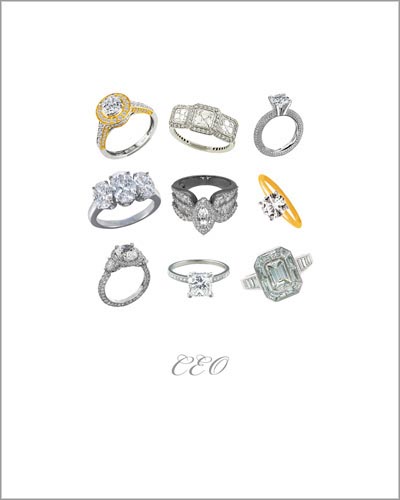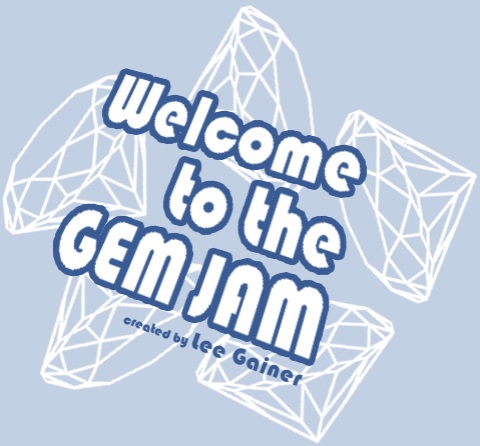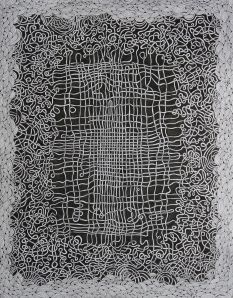All about the Bling…
January 30, 2012 § Leave a comment
Due to uncontrollable circumstances, I was unable to attend the Decathlon Artist Talk yesterday. A shame because I was looking forward to it. I would still like to share my reasoning for creating this body of work. *ahem*
Back in 2008, when my work concentrated on unwritten rules and media endorsed expectations, I created a print series entitled Two Months Salary. This series is made up of 20 10″ x 8″ prints, each displaying the name of an occupation and nine engagement rings. I collected data on the average salaries of several occupations (Farmer, Police Officer, Dentist, A List Actor, etc.) and then found nine rings that, according to Debeers, that person should purchase if they want their love to taken seriously by modern western society. The prints were made, people enjoyed them, and then I moved on.
The statement about the prints…
In May of 2006, a female Sunday Morning reporter went out on the streets of New York City to ask passers-by what they thought about her 3/4 carat diamond solitaire engagement ring. ”It says that he tried his best… but that it wasn´t good enough,” said one lady. “Well, its fine… for a friendship ring,” replied another. Another bystander replied that “you need a magnifying glass to see it.” The diamond engagement ring has evolved from a luxury item mostly purchased by the wealthy to a must have for any bride-to-be. In 1947, DeBeers began a marketing campaign to increase diamond sales, hoping to cash in on a growing post-war economy. Jewelers began using the guideline of two months salary as a standard. This campaign has been so successful that we now, as a society in general, equate a man´s personal worth and love for his future spouse with the size of a shiny rock. For many, size matters. If you visit WeddingChannel.com, you will find a ring budget tool that determines what you should spend. It divides your annual salary by 6 to come up with the “standard” two month guideline. Using this equation, along with the most recent average salary data gathered from the US Dept. of Labor and Payscale.com, I created a list of average salaries for a range of occupations. Images of rings were allocated to each occupation by price. There are 20 separate prints in this piece, each representing a specific occupation with 9 rings that, according to the jewelry industry, are the standard for that particular occupation´s salary.You can view all of the prints here at my website.
Approximately one and half years later, some obscure blog found this series and posted about it. Then a not so obscure blog picked up on it. Then the jewelry blogs, the feminist blogs, and the media got a hold of it. All of the sudden, my website was getting 30K+ hits a day! The work was written about in The Atlantic, The American Prospect, and The New York Times. Even radio stations were talking about this. Discussions ensued along with flat out arguing. What counts, before or after taxes? Should I go for size or quality? It was entertaining for me to read the comments, the back and forth. It showed how effective that DeBeers marketing scheme was and how deeply it has become entrenched into our idea of tradition. I recall quite a few people demanding that three (!) months salary should be spent to prove you love someone. Then a fateful comment, “… I cannot wait to see the book.” *face palm*
So I did more research, wrote an essay, designed a cover, and created 42 more pages of occupations with their rings and thus Two Months Salary: the book was born. It is available on Amazon. The book was a new experience (would do again) and became a mild success. During my research, I found a video of a young enlisted Marine prepping to ask his girlfriend to marry him. He showed the receipt for the ring (11K+) before displaying the ring. I thought that said a lot! I also discovered where several jewelry sites touted loan programs… in case you didn’t have two months salary on hand at that time. DeBeers.com had a two months salary calculator right on the front page. I was somewhat stunned but mostly amused. Book completed, I moved on. Fast forward to 2011 and the call for Decathlon Artist/athletes appeared. I decided to enter but I wanted to have some sort of overall theme. I choose my Two Months Salary work as a catalyst. It had already been a print series and a book, can I morph it into nine more mediums? I liked that challenge.
I believe that I met that challenge. I am happy with the works I created. They meet my aesthetic expectations and have an edge of humor about them. The painting for the Decathlon, Three Proposals, is an example of the process I am using now. Where before I considered myself open to use any medium warranted by my concepts, I now consider myself a painter. Having spent six months on all these decathlon pieces in all those very different mediums underscored my desire to become a more medium focused artist. And now I move forward.
I plan to have my new work on a new site within the next month or so. If you are curious, feel free to visit.
Hope you enjoy my works and all the pieces from the Decathlon artists. The show closes on Feb. 5th so hurry on over before it’s gone!
VOICE/MEMORY
January 15, 2012 § Leave a comment
What Might Have Been
January 15, 2012 § Leave a comment
Get your Jam on!
January 8, 2012 § Leave a comment
Want a sneak peek at Lee Gainer’s audio piece for the Decathlon? Visit http://www.leegainer.com/gemjam/gemjam.html to get your jam on now!
Lee Gainer — Escape
December 2, 2011 § 1 Comment
Three images overlaid, images created from photographs of Myrtle Beach, images of vacations and parades, images of escape.”Things that are supposed to be these places and these events outside of normal life”. Lee Gainer recalls family vacations to the Carolina destination, pictures of which were drawn atop one another with lines that collide into a web of pencil strokes. “Vacations…we expected a lot out of them.”
“That kind of thing has always interested me. It’s my grandmother’s fault. I was a 5 year old looking through these magazines — she always had these magazines lying around of Disneyworld and cruises. These works are about that, about escapism.”
What I find interesting is that, by overlaying these three images in a way that strips them of all recognition (except for certain bits of text) it creates quite the opposite of escape and calm — the lines collide and intersect to impress a feeling of disorder and claustrophobia. But when certain phrases pop out that are hidden within, you imagine the bits from your own childhood — strolling down a bustling boardwalk, festooned with flashing lights and bright signs, the sounds and scents and all sorts of distractions that, when remembered, seem so perfect. Looking into Gainer’s drawing, it’s almost like seeing visually a blueprint of how your brain recalls a memory.
November 22, 2011 § Leave a comment

This image reminds me of a killer piece that Mary is working on for the show. Can’t wait to see it done!
-Patrick
Conception
November 15, 2011 § 1 Comment
Lisa K Rosenstein, artist

It’s all conceptual isn’t it? All art begins in the mind, seemingly out of nowhere. Maybe it’s as Agnes Martin says, “…inspiration falls on us like rain in the night while we are asleep…”. From there an idea can grow if we take the time to consider it.
In the past 4 months my brain has been a place of wild growth, ideas sprouting up all over in a massive tangle or as Annie Dillard says, …”one big lunatic fringe…”. Much of these months have been spent exploring the undergrowth, categorizing, re-categorizing, cutting, re-attaching, and generally driving myself to a state of frozen confusion.
Now here we are less than two months out and all the projects are coming together into a mostly-cohesive state. Each piece relates to the other, visually and conceptually. One large conceptual collage of mind and matter.
Technique, Technique, Technique.
November 9, 2011 § Leave a comment
Commentator: Karen Joan Topping
Artist: Shanthi Chandrasekar
When last we met, I had started to broach the subject of technique, practice and repetition. We are not born with technique, we must master it. If you are to master it you must practice it so much that you stop thinking about it and become able to do it without thinking about what you are doing. Basically if you are doing it right, you do end up looking like you were born with it. Seems like a real shell game when you put it like that.
Watch an interview with a major athlete and they say things like: “We didn’t hustle enough”, “It wasn’t meant to be”, “We weren’t lucky enough to make it happen”, “We wanted it and we went out and got it.” It’s like they’re talking about evading a parking ticket. In a situation where optimum performance means that you are not thinking about what you are doing, it’s not surprising that putting thoughts into words becomes like trying to force a square peg into a round hole. Just doing it? There is a reason that’s a trademarked saying.
After years of experience, introducing myself as an artist I still get the feeling that many people have a very schematic view of what being an artist means. They want a round peg in a round hole. They either assume that you are a Picasso–like, one-in-a-million individual that actually was born being able to do it, or they assume you’re not. Most of us will not fit the schema of artist = Picasso, therefore they seriously don’t know what to make of us.
Well listen up now, even if you are Picasso, and you have mastered a lot of techniques, being an artist is a constant education. There always seems to be more to learn. My sculptural training involved carving in a much cheaper and softer material, plaster-of-paris. I’ve been around art studios for close to 20 years now and although alabaster is a classical material to use, it’s peppered throughout art history; I’ve never seen anyone working with it in real life before. I hope you enjoy this small peek at SHANTHI CHANDRASEKAR working on sculpting an alabaster block:
Transformations from one reality to another reality
November 4, 2011 § Leave a comment
From dream state to the waking state or from quantum mechanics to relativity, we are always in search of that ultimate truth that unfies everything. Our minds try to connect the dichotomy that exists all around and within us. Is it possible to have a theory that combines it all? May be in another dimension or a parallel universe? Do the two aspects of a dichotomy, though seemingly disconnected, create a whole together? Like the warp and weft of the fabric?
Using the Leftover Material
November 2, 2011 § Leave a comment








